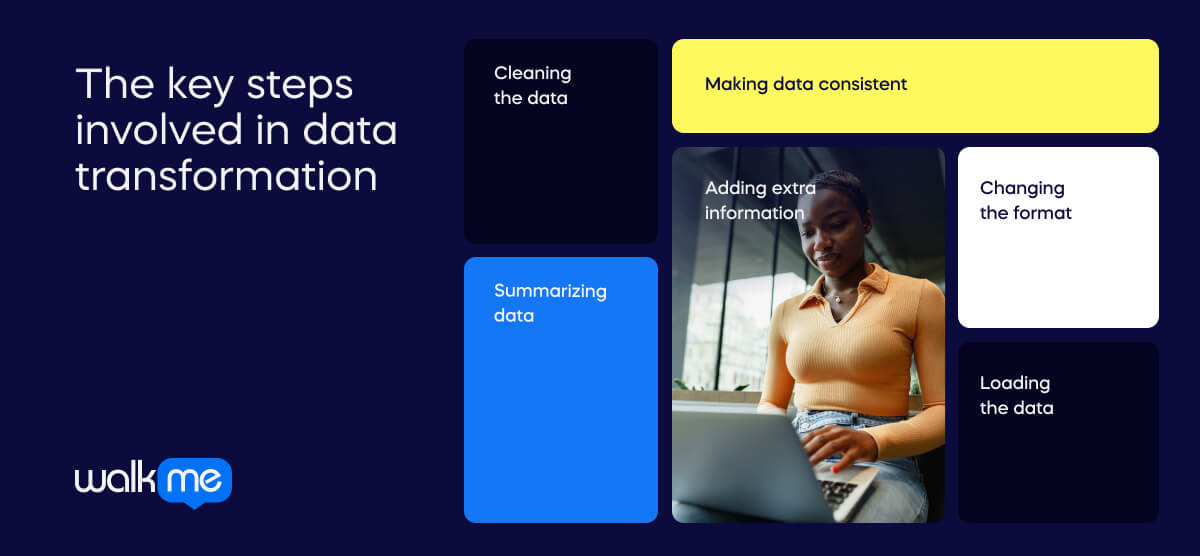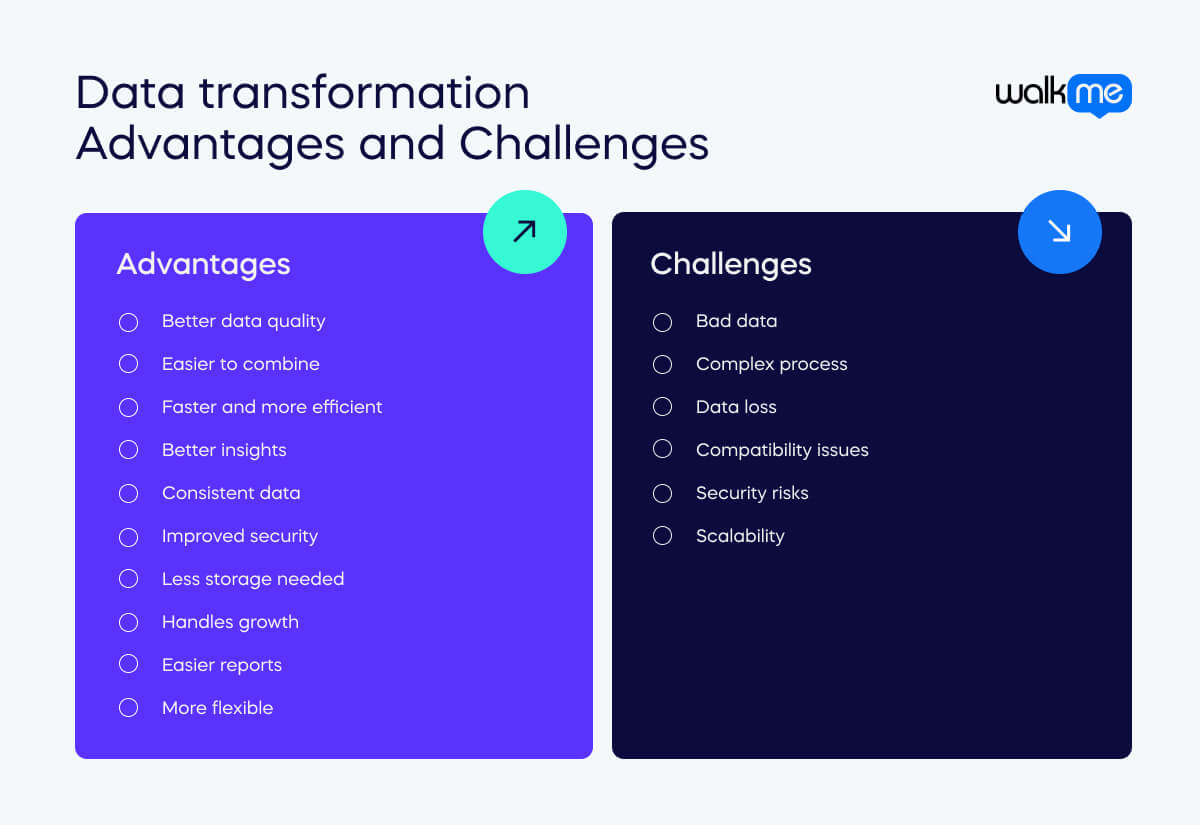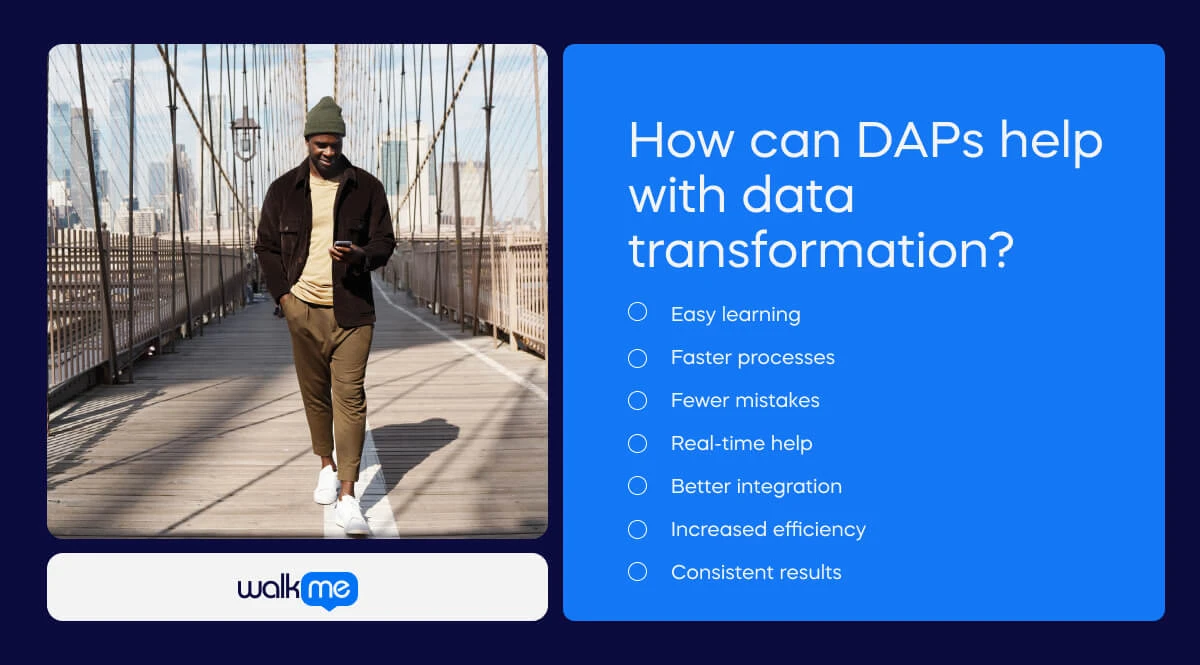Data transformation is the process of changing information so it becomes easier to use.
For example, data from various sources might come in different formats, such as numbers or words. The data needs to be adjusted or cleaned up to make this information work well together so that everything matches.
Sometimes, data from various places may look different. Data transformation helps to make all the information look the same, allowing it to be compared or combined easily. This is important for tasks like analyzing information, which businesses use to make
data-driven decisions.
Data transformation also involves changing the structure of data. For instance, a list of names might be turned into a table, or words might be converted into numbers so that computers can understand and work with them more effectively. This process makes the data more useful for specific tools or programs.
When data is moved from one system to another, data transformation ensures it fits properly in the new system. This helps to keep the information accurate and ready for use.
In essence, data transformation is about making raw information clean, clear, and prepared for any task it needs to perform.
This process is important for businesses to succeed. EY research reveals that one of the biggest reasons companies struggle with transformation is because
they don’t place enough value on trustworthy data.
Furthermore, McKinsey has shown that
organizations can reduce their IT costs and investments by up to 30% if they simplify their data architecture and reduce data fragmentation.
What are the key steps involved in data transformation?
![the key steps involved in data transformation]()
Understanding the key steps in data transformation is important for knowing how raw data becomes useful information. Each step helps ensure the data is correct, consistent, and ready to use.
These steps allow companies to prepare the data, making it easier to compare, combine, and understand. They ensure that the data is clean, in the right format, and has all the necessary details.
Let’s look at the key steps that make data transformation work well.
Cleaning the data
To ensure the data is correct, mistakes are fixed, duplicates are removed, and missing information is filled in.
Making data consistent
Changing data to a common scale or format so that it’s easier to compare and use together.
Summarizing data
Combining data from different places into a simple format, like finding the average or total.
Adding extra information
Enhancing the data by including more details, like adding location information to customer records.
Changing the format
Converting data from one type to another, like turning words into numbers.
Loading the data
Putting the changed data into a new system or tool so it’s ready to use.
Data transformation vs data cleaning
Data transformation and cleaning help prepare data for use, but they perform different actions.
- Data transformation changes how the data is organized or formatted to fit what’s needed.
- Data cleaning fixes mistakes and removes duplicates to ensure the data is correct.
Let’s look at how these two steps differ and how they each help make data useful.
| Data transformation |
Data cleaning |
| Definition |
Changing data into a different format or structure so it can be used better. |
Fixing mistakes in the data and removing any errors or duplicates to make it correct. |
| Focus |
Changing the data’s shape or format to fit what’s needed. |
Making sure the data is accurate and has no errors. |
| Techniques |
- Changing the data’s format
- Combining data
- Adding extra information
|
- Finding and fixing mistakes
- Removing duplicates
- Filling in missing information
|
| Goals |
Get the data ready in the right format for use or analysis. |
Make sure the data is correct, complete, and free from errors. |
| Examples of use |
Changing sales data from different sources into the same format so it can be analyzed together. |
Removing repeated customer entries from a list ensures the data is accurate. |
Use cases for data transformation
Data transformation is important in different business situations.
Whether it’s organizing sales data to make reports, merging customer information to improve marketing, or combining inventory data for better management, data transformation makes it more useful.
It can be difficult to see how this works in practice, so here are three examples of how data transformation helps in different business settings.
Sales reporting
Sales data from different regions often arrive in various formats, such as differing date styles and currency symbols.
Data transformation processes convert these diverse formats into a standardized form to ensure consistency, allowing the data to be combined and analyzed collectively.
This standardization is crucial for creating clear and comprehensive sales reports, enabling businesses to compare and assess sales performance across all regions.
Customer insights
Customer information is collected from various sources, including websites, social media, and in-store purchases.
Data transformation processes consolidate this information into a cohesive format and enrich it with additional details.
This integration and enhancement of customer data give businesses a clearer and more comprehensive understanding of their customers, enabling more effective marketing strategies and personalized customer interactions.
Inventory management
Inventory data is often recorded in different systems, each using various formats.
Data transformation processes standardize this information into a consistent format and consolidate it into a central repository.
This uniformity allows businesses to track stock levels and manage supplies more accurately, leading to improved efficiency in inventory management and better decision-making.
What are the advantages of data transformation?
![Data transformation Advantages and Challenges]()
Transforming data has many benefits that help businesses use information better. By changing data into a clearer and more organized format, companies can ensure accuracy, work faster, and keep data safe. This helps in making smarter decisions and managing data more easily.
Let’s look at the main advantages of data transformation and how it can improve business.
Better data quality
Data transformation helps correct inaccuracies and inconsistencies, ensuring that all information is accurate and reliable. By cleaning and standardizing the data, businesses can trust its integrity for decision-making and analysis.
Easier to combine
When data from various sources is converted into a uniform format, it becomes easier to merge and analyze. This integration helps understand relationships between different data sets, providing a more comprehensive view of the information.
Faster and more efficient
Transformed data is optimized for use with various tools and systems, enhancing overall efficiency. Processes run more smoothly and quickly, as the data is already in a format compatible with the software and systems being used.
Better insights
Well-organized data makes it simpler to identify trends and patterns. This improved clarity allows businesses to make informed decisions and derive valuable insights from their data, leading to more strategic and effective actions.
Consistent data
Transforming data ensures that all information is standardized, maintaining consistency across different datasets. This uniformity helps prevent discrepancies and ensures all data aligns correctly, facilitating accurate reporting and analysis.
Improved security
Transforming data can include measures to enhance its security, such as encryption and anonymization. This helps protect sensitive information and reduces the risk of data breaches, ensuring that private data remains secure.
Less storage needed
Transformed data is often more compact and organized, which can reduce storage requirements. Efficient data storage saves space and improves access and retrieval times, making data management more effective.
Handles growth
As a company expands, data transformation processes can be scaled to manage increasing volumes of data. This scalability ensures the data remains manageable and useful, supporting the company’s growth and evolving needs.
Easier reports
Transforming data simplifies the creation of reports and visualizations. With data organized in a consistent format, generating charts, graphs, and reports becomes more straightforward, leading to clearer and more actionable insights.
More flexible
Well-transformed data can be easily utilized across different systems and for various applications. This flexibility allows businesses to adapt their data for other purposes, enhancing its utility and supporting diverse analytical needs.
What are the challenges of data transformation?
Now, let’s look at the challenges of data transformation. Changing data can be very helpful, but it can also raise some issues. Knowing about these problems can help companies handle them more effectively.
Let’s review the common issues organizations might face and how they can affect the process.
Bad data
If the original data is flawed or inaccurate, the transformation process may not fully resolve these issues. Poor-quality data can still lead to errors or misleading results, regardless of how well it is transformed.
Complex process
Data transformation can be intricate, particularly with large volumes of data or complex conversion requirements. The complexity of the process can pose challenges and require specialized expertise to manage effectively.
Data loss
During transformation, there is a risk of losing or altering information. Ensuring data integrity throughout the process is crucial, as any loss or modification can impact the accuracy and usefulness of the final dataset.
Compatibility issues
Different systems may have varying requirements and formats, which can complicate the integration of transformed data. Ensuring compatibility between systems is essential to avoid issues with data usability and functionality.
Security risks
Handling and transforming data, especially sensitive information, can introduce security risks. Protecting data from unauthorized access and ensuring its security throughout the transformation process is critical to safeguarding privacy.
Scalability
As the volume of data increases, scaling the transformation process can become challenging. Adapting to growing data needs may require adjustments to the process and additional resources, which can be difficult to manage.
How can DAPs help with data transformation?
![How can DAPs help with data transformation_]() Digital adoption platforms (DAPs)
Digital adoption platforms (DAPs) can make data transformation easier and more effective. They provide tools and support that help users change and manage data more smoothly. DAPs offer simple guides, automate tasks, and help prevent mistakes.
Let’s examine how DAPs can improve the data transformation process and make it easier for businesses to use their information.
Easy learning
DAPs offer
simple guides and tutorials to help users learn how to handle and change data.
Faster processes
They
automate repetitive tasks, which speeds up the data transformation process.
Fewer mistakes
With clear instructions and support, DAPs
help reduce errors during data transformation.
Real-time help
They provide
instant help and answers to solve problems quickly.
Better integration
DAPs help different tools and systems work together, making transforming data from various sources easier.
Increased efficiency
They guide users and automate tasks, making the process faster and more efficient.
Consistent results
DAPs ensure that data transformation is done the same way each time, leading to reliable results.
 Understanding the key steps in data transformation is important for knowing how raw data becomes useful information. Each step helps ensure the data is correct, consistent, and ready to use.
These steps allow companies to prepare the data, making it easier to compare, combine, and understand. They ensure that the data is clean, in the right format, and has all the necessary details.
Let’s look at the key steps that make data transformation work well.
Understanding the key steps in data transformation is important for knowing how raw data becomes useful information. Each step helps ensure the data is correct, consistent, and ready to use.
These steps allow companies to prepare the data, making it easier to compare, combine, and understand. They ensure that the data is clean, in the right format, and has all the necessary details.
Let’s look at the key steps that make data transformation work well.
 Transforming data has many benefits that help businesses use information better. By changing data into a clearer and more organized format, companies can ensure accuracy, work faster, and keep data safe. This helps in making smarter decisions and managing data more easily.
Let’s look at the main advantages of data transformation and how it can improve business.
Transforming data has many benefits that help businesses use information better. By changing data into a clearer and more organized format, companies can ensure accuracy, work faster, and keep data safe. This helps in making smarter decisions and managing data more easily.
Let’s look at the main advantages of data transformation and how it can improve business.
 Digital adoption platforms (DAPs) can make data transformation easier and more effective. They provide tools and support that help users change and manage data more smoothly. DAPs offer simple guides, automate tasks, and help prevent mistakes.
Let’s examine how DAPs can improve the data transformation process and make it easier for businesses to use their information.
Digital adoption platforms (DAPs) can make data transformation easier and more effective. They provide tools and support that help users change and manage data more smoothly. DAPs offer simple guides, automate tasks, and help prevent mistakes.
Let’s examine how DAPs can improve the data transformation process and make it easier for businesses to use their information.
